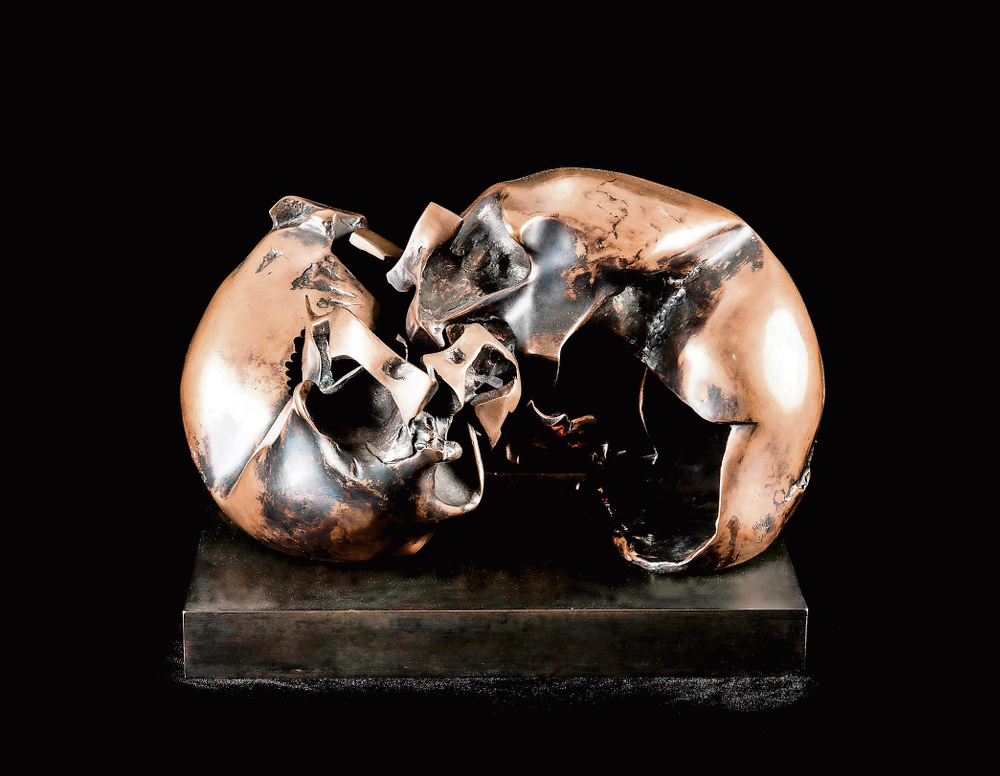Shaping history: A detail of 'Crucible'.
Monuments are tricky things. National ideologies can change on a whim, as the Fallen Monument Park in Moscow’s Muzeon arts park proves. Littered around the grounds are remnants and fragments of discarded, saccharine public sculptures. The rejection of Soviet and communist ideas in the early 1990s led to a spate of removals from public spaces of images that had, once upon a time, commemorated the official version of the past and heralded the planned future.
Against this backdrop, as well as the #RhodesMustFall campaign that wants to consign colonial and apartheid-era public art to Trotsky’s “dustbin of history”, the retrospective of the late Neels Coetzee’s sculptures, maquettes and drawings provides an interesting take on what public artwork could be: something infinitely more open-ended than the declarative realism or stylised idealism of much commemorative sculpture.
Titled Crucible and exhibited at Johannesburg’s Circa gallery and its satellite space within the building, Speke, the show has now been expanded and edited to include artist Bronwyn Lace’s responses to Coetzee’s work, titled Response. It is a sprawling yet cogent overview of Coetzee’s work and artistic life, giving equal weight to resolved bronzes and embryonic sketchbook concepts alike.
The show is especially valuable because Coetzee seldom exhibited commercially during his lifetime (although his creation of the Democracy Wall for the Institute for Democracy in Africa was praised in Parliament). His effect on the Johannesburg visual arts scene was felt primarily through his role as a sculpture lecturer at the University of the Witwatersrand’s fine arts department, where he taught from 1972 to 1997. I was privileged enough to do two academic blocks with him during my undergrad years there, and found him to be engaged and thoughtful.
The culminating work of the show, also titled Crucible (1994-1995), has not until now been shown as a public work. In the gallery space, it reads as a large-scale sculptural installation, and is exhibited to great effect by curator Koulla Xinisteris under an illuminating spotlight.
It was conceived by Coetzee as a shrine to all those suffering “abuse, deprivation, incarceration, for whatever reasons”. Crucially, the work is made of metal from melted-down AK-47 assault rifles.

Neels Coetzee’s ‘Untitled’.
The crucible of the title is a reference not just to the process of this melting down but also to the forging of a nation by means of the trials of apartheid and the pre-election township wars of 1990 to 1993. It’s a compelling work, at once forbidding, with its regular, prison-bar-like stakes of steel, and intriguing, with mysterious, shroud-like cast-bronze forms suggesting interred bodies.
The whole is topped by a small cast of a section of a tree branch with two twigs reaching upwards in a V shape: the suggestion of a fragile peace is inescapable. The threat of civil war still pervaded South Africa at the time of this work’s completion.
But the resonances of Crucible are much broader. During the 1970s and 1980s, the AK-47 became a symbol of the flood of liberation struggles that swept across the subcontinent – to this day, the silhouette of Mikhail Kalashnikov’s most famous design forms part of the Mozambican national flag.
In a strange way, Coetzee’s central piece pays homage to that part of the struggle; he seems to acknowledge the desperation of the fight against colonialism and apartheid, but suggests that from the violence and national bloodletting of apartheid’s death throes could come much creation. In this work, the creative act becomes a form of real alchemy, transforming the base metal of the gun into art, at once neutralising its threat and activating other lives for it.
Another standout series on the exhibition involves skulls, bent and distorted into new shapes. In particular, one small, untitled bronze from 1976-1977, a half-squashed skull tenaciously holding up a small shield to protect itself, remained with me long after my visit to the show. Coetzee had written at length about the recurrence of the skull motif in his work: “[T]he skulls became torsos, bodies … they became foetuses … The lacerations are interruptions into a harmonious flow. This emphasises the vulnerability of an already distorted form.”
Another in the series, Fractured Skull on a Bed of Thorns, offers a broken remnant of life, its lacerated forms and surfaces bespeaking the immeasurable violence our species is capable of inflicting on its own.
It was in these two directions, then, that Coetzee’s artistic explorations excelled: vulnerability and redemption, as if a grasp of the first could lead to the second. Through a slow-burning career that was less public than those of his peers such as Walter Oltmann and Peter Schütz, Coetzee wrought an understanding of the human condition that brings depth to our memories of the otherwise desperate years of high apartheid.
Worth a final mention, in this vein, is the Avçilar series of shrouded portals, named for a Turkish shrine. Of these, Shrouded Vestibule is the most moving, its flattened top intentionally recalling Table Mountain’s concealing “tablecloth” of cloud cover.
Inevitably, as in the work of Mark Rothko, with whom Coetzee shared a preoccupation with death and life beyond this world, the works have accrued gravitas since his death. As Xinisteris says in the exhibition’s catalogue essay, the series links to Coetzee’s “post-humanist interest in the nature of the life force intrinsic to all matter”.
This depth marks Coetzee’s transcendence above the sea of agitprop work made in South Africa in the period during which he worked. The show makes it difficult to ignore that depth, as we move further away each year from post-liberation euphoria.
This review was generated as part of an initiative run by Mary Corrigall @IncorrigibleCorrigall, in which galleries and curators sponsor reviews for publication. They have no input into the content of the review. Crucible and Response are on until October 29